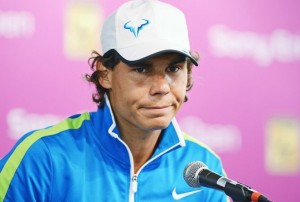By Thomas Swick
If not for Andy Roddick, tennis fans would probably have woken up yesterday morning eager for Fab Four Friday at the Sony Ericsson Open. One assumes that, had he not lost to Roddick, Roger Federer would have gone on to defeat Juan Monaco and Mardy Fish and taken his rightful – and widely anticipated – place alongside Andy Murray, Rafael Nadal and Novak Djokovic in the semifinals.
But we still had Nadal versus Murray. Or did we? A little after 1 pm I looked out the window of the media center and saw Murray practicing on the stadium court with Radek Stepanek. This would not have been noteworthy except for the fact that the women’s semifinal doubles match was supposed to be taking place down there. And, as Neil Harman of the London Times pointed out, Stepanek is right-handed.
At the media information desk we were told that the women’s doubles had been moved to 3 pm, the originally scheduled time of the Nadal-Murray match. This immediately prompted speculation that Nadal had pulled out. About 15 minutes later we heard the announcement that he had.
Fab Four Friday had become Fab One Friday.

Reporters headed downstairs for the Nadal press conference. The Spaniard sat behind the microphone in training jacket and cap, his head bowed. I thought it was in dismay or disgrace until I realized that he was texting. When he started to speak, we learned, as we suspected, that the problem was with his knee. That was pretty much the “news” from the ten-minute exchange.
I was struck, once again, by the disconnect – not just in content but in texture – between the reporters’ questions and the athletes’ answers. The former are precise, cogent, earnest, eager for information while the latter are very often vague, fragmented, cagey, designed for obfuscation. The reporter sends across the dais a strong but perfectly returnable serve and the player deflects it back with a purposefully wobbly mishit that sails off into the seats.
I also came away with a sense of the harsh reality of the game. Fans cheer great play often without understanding the toll it takes on players’ bodies. Even in tennis.
“Poor Rafa,” Harman said when we were back at our desks.
Others were less compassionate. A woman who had just arrived for the day asked: “So there’s nothing till 7?”
“Women’s doubles,” I told her. She looked as if I’d said ‘shuffleboard.’
“That’s five hours of my life wasted.”
It was a tough day for sports writers who never leave the press box. I went for a walk.
On the steps of Court 1 a couple reclined in the shade.
“You came for the Nadal match?” I asked.
“Yes,” the woman said. “I want to cry.”
They had flown to Miami from Santiago, Chile. This morning they had arrived at 11 and gone to Court 4, hoping to see Nadal practice, as they had a few days earlier. When they got the news of his injury, they were not surprised.
“He practices much harder than Djokovic and Federer,” Pamela said. They were going soon to try to find Djokovic’s practice session – “He practices two or three hours before a match” she informed me – though her favorite player was Federer.
“I saw him play at the U.S. Open – and I was crying.”
Clearly, there is crying in tennis.
I thought the vendor business might pick up, with few people in the stadium, but a young woman selling popcorn and lemonade told me: “Just the opposite. It’s gonna be slow till this evening.”
That wasn’t the case in the Veuve Clicquot tent.
“We’re disappointed,” Frank from Fort Lauderdale said, “But we’re trying to drown our sorrows.” He looked at his wife being helped back into her chair. “Some of us have successfully drowned our sorrows.”
No one thought Nadal was malingering. “He’s not about to quit,” Frank said. “He’s a macho man.”
Two tables away, a man and a woman sat in front of two flutes of champagne. “We heard about Nadal on the bus,” the man told me. “So I said: ‘Let’s get drunk.’”
Clearly, there is drinking in tennis.
Over at the Corona bar, Shola from Pittsburgh was having a beer with a friend from Jamaica. “I worry for Nadal,” he said. “This knee injury looks like it could be a recurring problem.”
Katie, Angie and Faramarz, standing nearby, didn’t have tickets for any matches; they had come into the tennis center just to watch on the big screen. “The atmosphere is much better here,” Faramarz said, “than watching at home.”
Back in the media center, I saw through the windows Djokovic practicing on the stadium court. (I hoped Pamela was not wandering around the outside courts.) At one point he turned the racket around, and, holding the frame, hit the ball with the handle, sending it into the stands. Then he ran around imaginary bases.
A few hours later he won the first set at love. Monaco fought bravely to send the second into a tiebreak (which he lost). So the fans got some drama. Though a number of them surely walked out of the stadium thinking uncharitably of Andy Roddick.
